The HTC One (M8) Review
by Anand Lal Shimpi & Joshua Ho on March 26, 2014 7:00 PM EST- Posted in
- Smartphones
- HTC
- Mobile
- HTC One
Snapdragon 801 Performance
The M8 is the first smartphone we’ve tested to use Qualcomm’s newly announced Snapdragon 801 SoC. At a high level the 801 is a frequency bump enabled by a 28nm HPm process push, giving it a tangible increase in performance (and potential decrease in power consumption) compared to the outgoing Snapdragon 800. The table below compares the 801 variants to the Snapdragon 800:
| Snapdragon 800/801 Breakdown | ||||||||||
| SoC Version | Model | Max CPU Frequency | Max GPU Frequency | ISP | eMMC | DSDA | Memory IF | |||
| MSM8974VV | v2 | S800 | 2.2GHz | 450MHz | 320MHz | 4.5 | N | 800MHz | ||
| MSM8974AA | v2 | S800 | 2.3GHz | 450MHz | 320MHz | 4.5 | N | 800MHz | ||
| MSM8974AB | v2 | S800 | 2.3GHz | 550MHz | 320MHz | 4.5 | N | 933MHz | ||
| MSM8974AA | v3 | S801 | 2.3GHz | 450MHz | 320MHz | 5.0 | Y | 800MHz | ||
| MSM8974AB | v3 | S801 | 2.3GHz | 578MHz | 465MHz | 5.0 | Y | 933MHz | ||
| MSM8974AC | v3 | S801 | 2.5GHz | 578MHz | 465MHz | 5.0 | Y | 933MHz | ||
In most parts of the world the M8 will ship with a 2.3GHz Snapdragon 801. In Asia/China however we’ll see the 2.5GHz MSM8974AC v3 SKU instead.
Compared to the outgoing Snapdragon 800, peak CPU performance shouldn’t increase all that much. What we may see however is an improvement in power efficiency thanks to the improved 28nm HPm process.
It’s really the GPU that will see the largest increase in performance. With a maximum speed of 578MHz and paired with faster LPDDR3-1866 memory, we should see up to a 30% increase in GPU bound performance over Snapdragon 800 designs.
- Physics
| Snapdragon 801 vs 800 vs 600 | |||||||
| HTC One (M8) - Snapdragon 801 | Google Nexus 5 - Snapdragon 800 | HTC One (M7) - Snapdragon 600 | 801 vs 800 | 801 vs 600 | |||
| SunSpider 1.0.2 | 772.8 ms | 686.9 ms | 1234.8 ms | -12% | +37% | ||
| Kraken Benchmark 1.1 | 6745.2 ms | 7245.9 ms | 12166.5 ms | +7.4% | +45% | ||
| Google Octane v2 | 4316 | 3726 | 3103 | +16% | +39% | ||
| WebXPRT Overall | 373 | 392 | 244 | -5% | +53% | ||
| AndEBench - Native | 17430 | 17480 | 12381 | -1% | +41% | ||
| 3DMark 1.1 Ultimate | 19631 | 17529 | 10519 | +12% | +87% | ||
| 3DMark 1.1 Ultimate - Physics | 50.5 | 51 | 33.1 | -1% | +53% | ||
| Basemark X 1.1 - HQ | 12194 | 11275 | 4807 | +8.1% | +154% | ||
| GFXBench 3.0 - Manhattan Onscreen | 11.1 fps | 9.3 fps | 5.1 fps | +19% | +118% | ||
| GFXBench 3.0 - Manhattan Offscreen | 10.4 fps | 8.7 fps | 4.4 fps | +20% | +136% | ||
| GFXBench 3.0 - T-Rex HD Onscreen | 29.9 fps | 24.3 fps | 12.6 fps | +23% | +137% | ||
| GFXBench 3.0 - T-Rex HD Offscreen | 27.9 fps | 22.9 fps | 12.6 fps | +22% | +121% | ||
CPU Performance
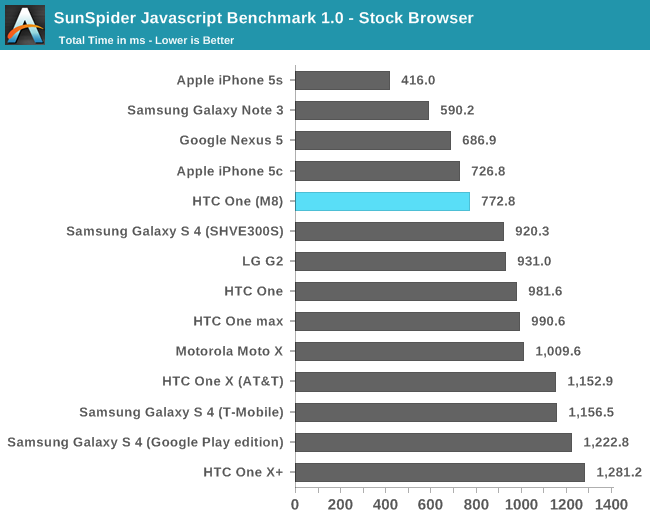
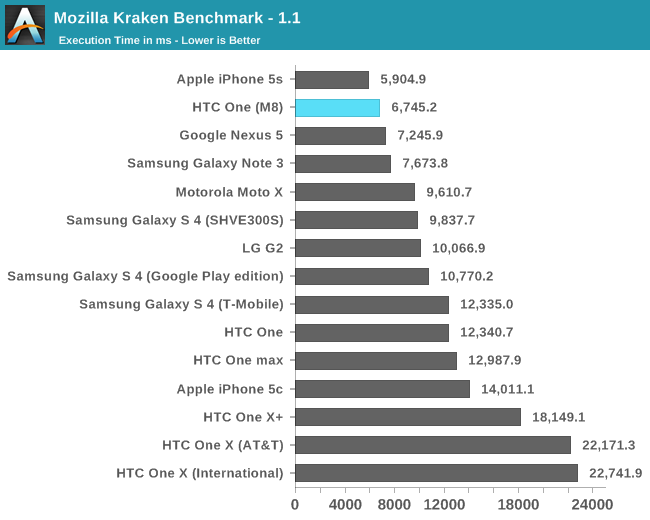
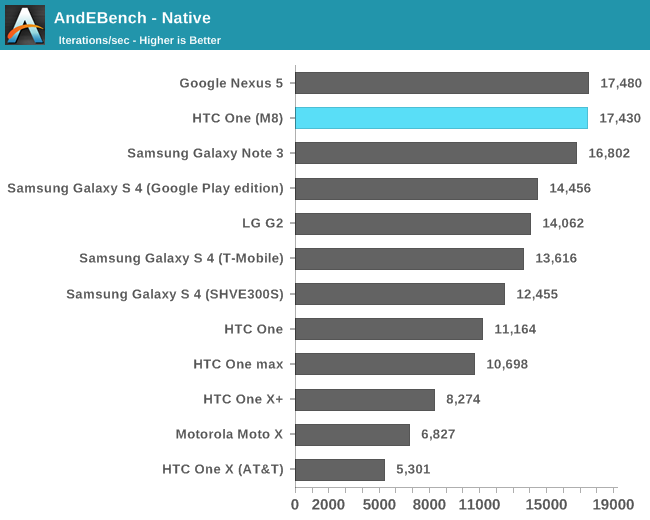
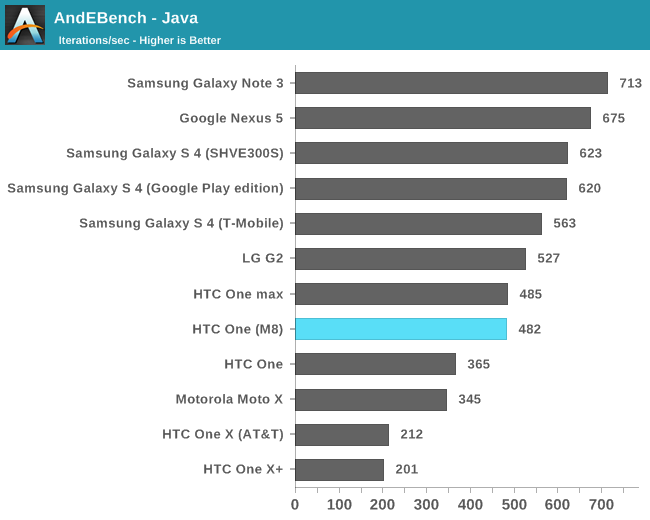
GPU Performance
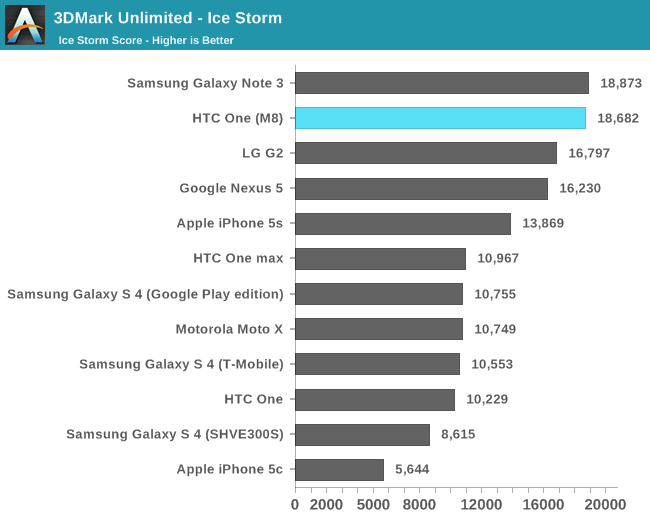
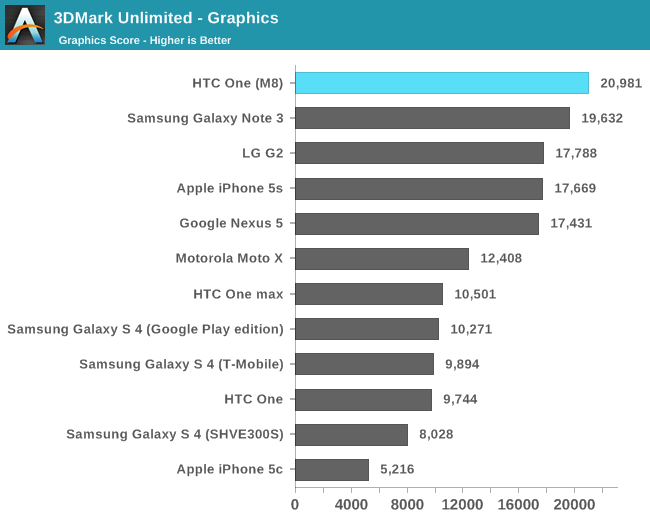
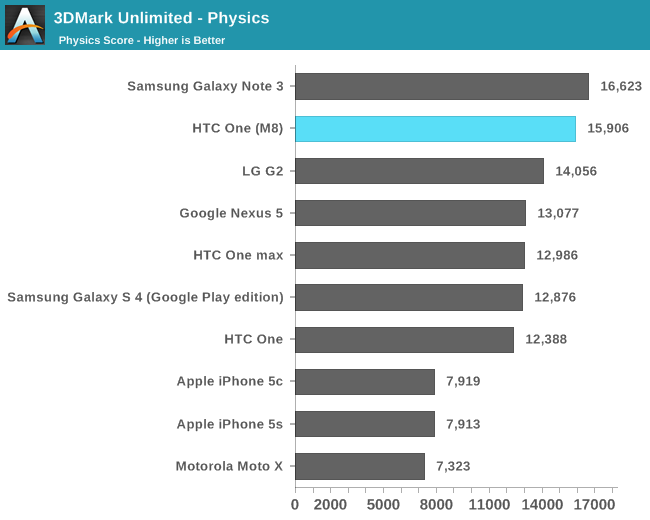
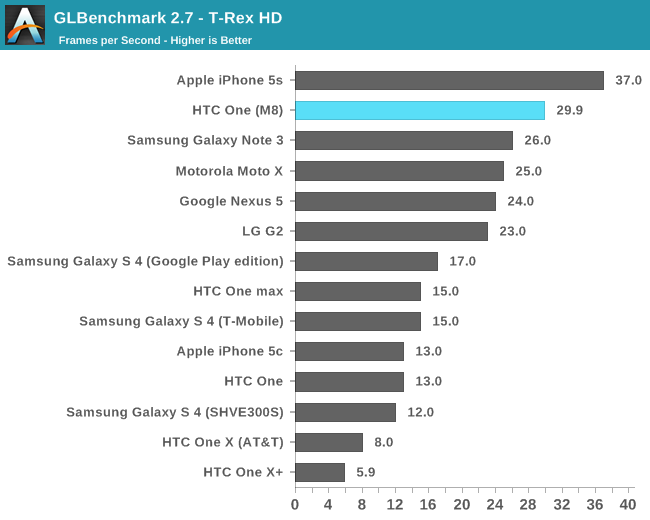
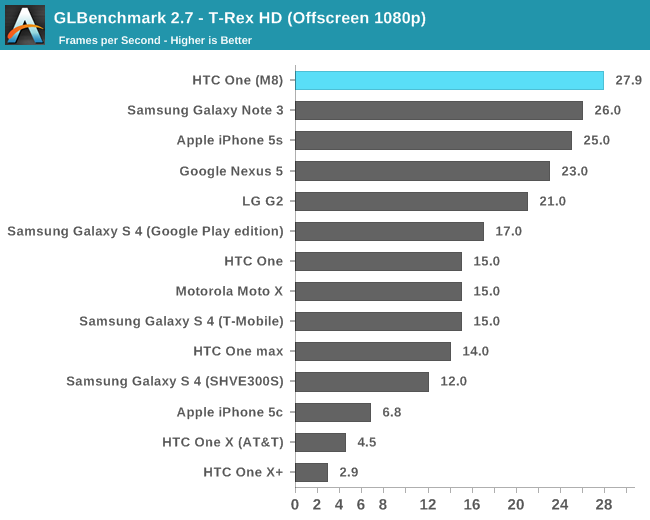
NAND Performance
The One is available in either 16GB or 32GB configurations, there are no higher capacity versions offered. There is now a micro SD card slot on the right side of the device, just above the volume rocker.
Despite using a Snapdragon 801 SoC, the internal storage is still an eMMC 4.5 solution.
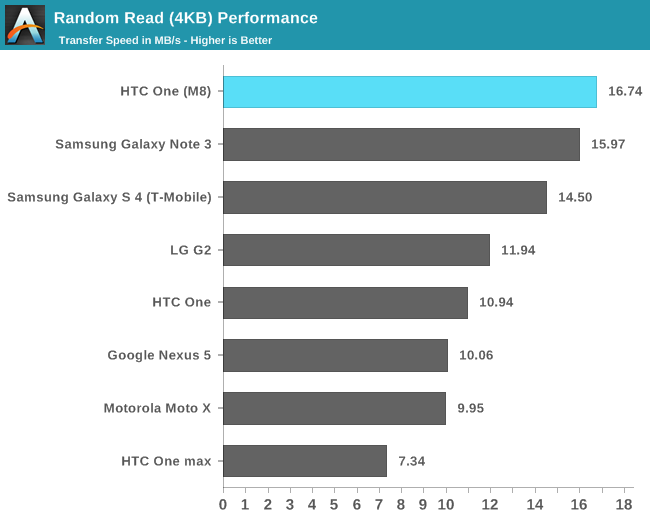
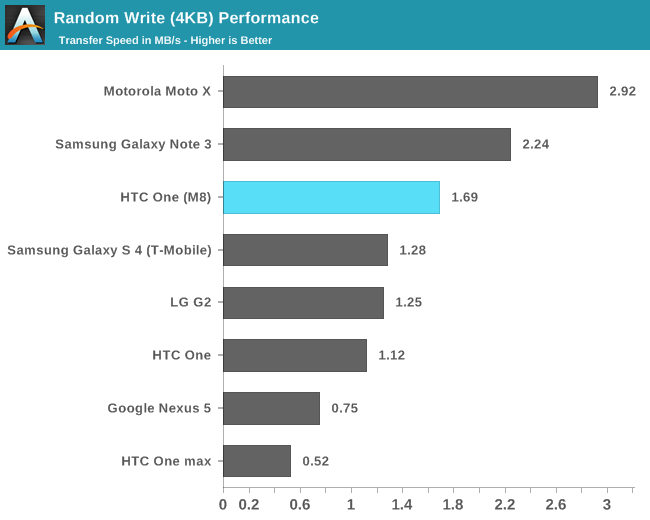

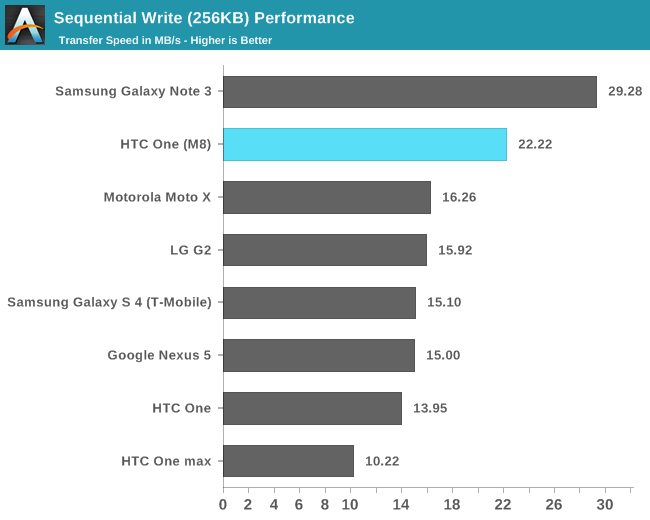


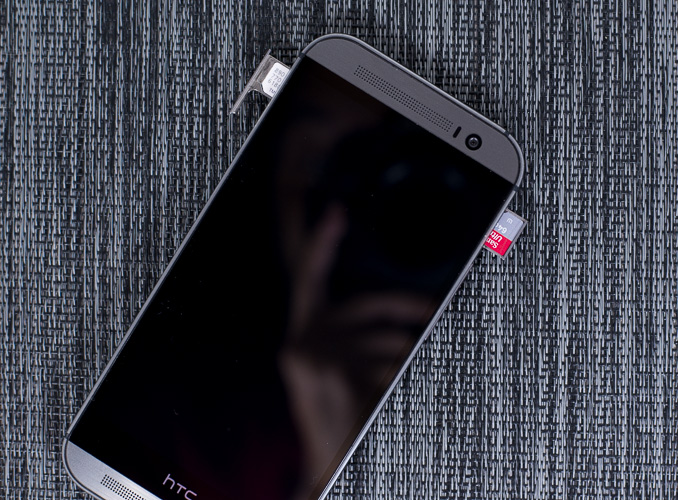








222 Comments
View All Comments
Mugur - Friday, March 28, 2014 - link
What I hate about the onscreen buttons is when you are using the phone in landscape mode and they take a lot of real estate of the screen... So I think I will stay another year with my "old" One (M7) - unless they cannot replace/repair under warranty my broken focus of the camera...martinpetrov1568 - Thursday, March 27, 2014 - link
Anand u say it is difficult and takes multiple exposures to create a photo such as the duo camera, but it is not. A normal photo with no blur from the depth of field simply needs a gaussian blur filter along with a soft brush in photoshop. I can do it, along with anyone else in this planet in 3 minutes tops. I'm sure there is a mobile application for this toosevenmack - Thursday, March 27, 2014 - link
But most people don't have Photoshop, Martin, and many of the photo apps out there focus on other kinds of filter (including ones that change colors) instead of Gaussian blur. So Anand is correct that it can be hard for the average person without graphic design software to do.NesuD - Thursday, March 27, 2014 - link
Double tap will put the screen back to sleep but only when the phone is in a locked state.NesuD - Thursday, March 27, 2014 - link
Been using mine for a day and a half now and everything about it has impressed me so far.djw39 - Thursday, March 27, 2014 - link
Reading this review on chrome for Android and the aspect ratio of the still pictures is offwillis936 - Thursday, March 27, 2014 - link
It looks quite nice but aside from the bump in screen size, battery and CPU I don't see much in the way of improvements. There are small things like faster radios and of course everything software related and that rather interesting dual camera trick, but for the most part it's just the generational gimmicks. All of this is well and good but the unnoticed significant regression in display quality and loss of OIS is crucial. OIS in particular. That's one of the best things you can put on a phone camera and just disappeared from the nicest looking android.marcn404 - Thursday, March 27, 2014 - link
Using a pair of stereo images, a depth map can be created. UFocus probably uses this depth map to blur part of an image which is at a certain depth. That's why in the picture above, the table is in focus as well as the main subject, since both are at the same depth. That's how it should be with a real camera, so this shouldn't be regarded as a limitation.ccd2 - Thursday, March 27, 2014 - link
My best guess is that the market is going to move away from "kitchen sink" phones like the S5 or even this phone. I think market, particularly for premium phones, will start to break into niches. Some people like larger phones, others may place a premium on the camera, still others may want a business orientation to their phone or want the phone to emphasize entertainment. As an example, as a Note 3 owner, I could care less about the S5. But this is my second Note phone and am leaning towards getting another Note when the time comes.chang3d - Thursday, March 27, 2014 - link
Your cellular band support chart on the front page for Sprint is missing some information. Sprint's model does support the same GSM/WCDMA bands that the Verizon model has.